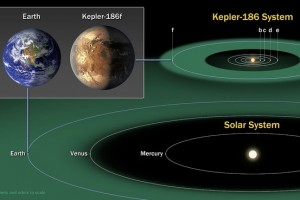Good morning.
Saturday in town will be beautiful, with sunny skies and a high of sixty-five. Sunrise today is 6:07 AM and sunset 7:42 PM. The moon is in a waning gibbous phase with seventy-eight percent of its visible disk illuminated.
In the FW third-annual Easter candy poll, there’s an upset of sorts – jelly beans bested chocolate rabbits atop the poll. Of all responses, 34.21% were for jelly beans, 26.32% for chocolate rabbits, 21.05% for marshmallow peeps, 11% for other, and 7.89% for Cadbury eggs.
Four-hundred, fifty-nine light years from our planet, there may be a world of similar size with liquid water:
Using the Kepler space telescope, Elisa Quintana of the SETI Institute at the National Aeronautics and Space Administration’s Ames Research Center in California and her colleagues detected the planet around a relatively small, cool, reddish star in the constellation Cygnus, which is located about 459 light years from Earth.
Known officially as Kepler-186f, the planet is the outermost of five Earth-size worlds orbiting in that star’s solar system, the scientists said at a news conference Thursday. They also reported their findings in the journal Science.
In the search for worlds where life might take hold, scientists so far have detected 20 potentially habitable planets around other stars. But this one is the first so close in size to Earth that is located within its star’s so-called habitable zone, where it receives the right amount of solar radiation so that water there wouldn’t boil or freeze, the researchers said.
“This is the first validated Earth-sized planet in the habitable zone of another star,” Dr. Quintana said. “We can now say other potentially habitable worlds the size of Earth can exist.”

